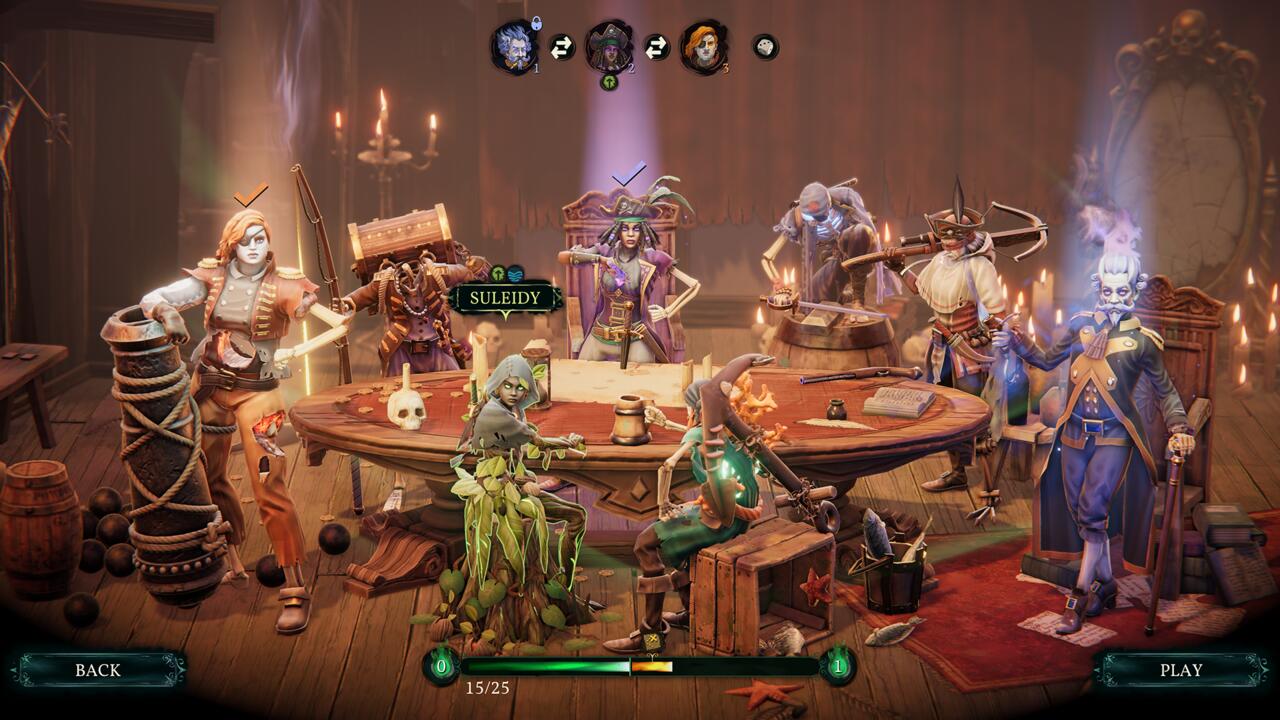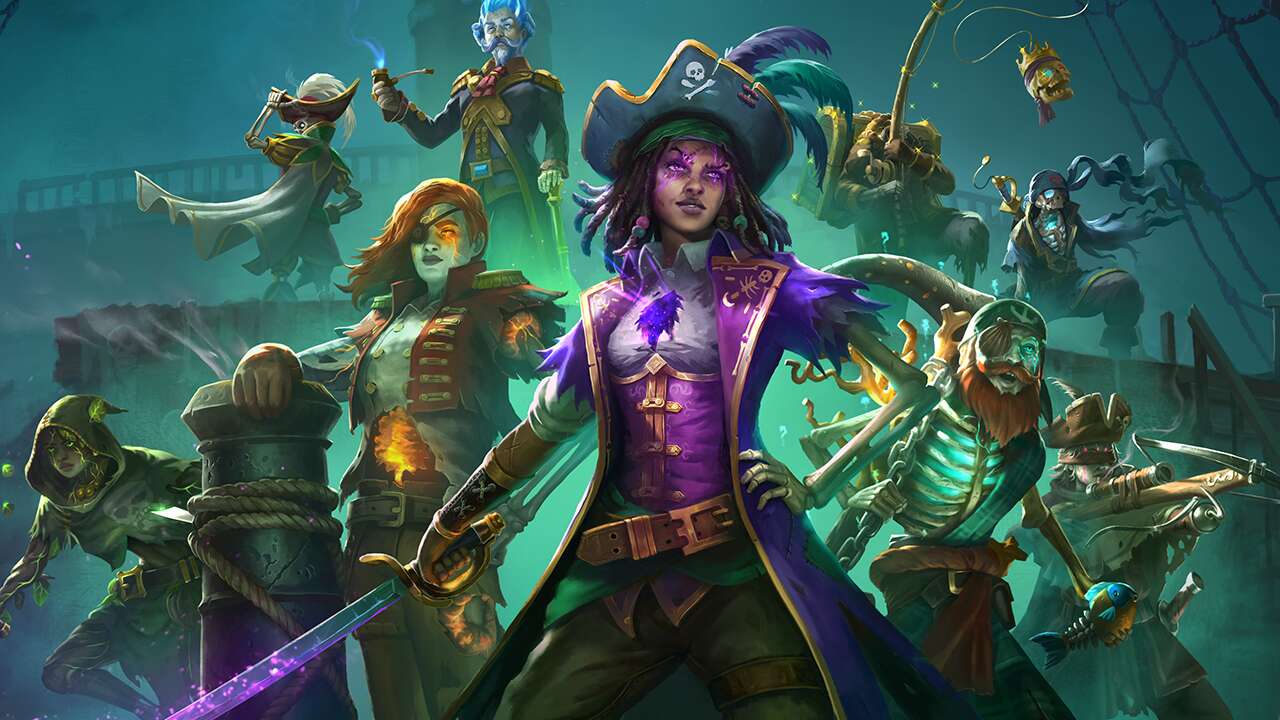Shadow Gambit: The Cursed Crew Review – Spectacul-arrrr
Pirates of the Caribbean: The Curse of the Black Pearl is an ideal summer movie. The franchise went on to become single-mindedly obsessed with its breakout star, Captain Jack Sparrow, but the first movie was an agile, lightly spooky swashbuckling adventure. Shadow Gambit: The Cursed Crew shares that movie’s spirit of goofy haunted slapstick with a heart and real dramatic stakes, and blends it with an expertly crafted stealth-strategy campaign. It all comes together into one of my favorite games of the year.
Shadow Gambit centers around the Red Marley, a living, talking ghost ship with an undead crew who have fallen to the Inquisition of the Burning Maiden. You play primarily as Afia, as she revives the cursed compatriots one by one and gathers information on the hidden treasure of the Red Marley’s captain, Captain Mordechai, who is conspicuously absent. The search for Mordechai’s treasure is an intriguing hook that propels the plot forward and balances well against the often eccentric subplots of the individual characters.
The crew is distinctly drawn with one-of-a-kind visual attributes and backgrounds that makes discovering each team member a joy. Afia is permanently seen with a spectral sword sticking out of her chest, which she draws to eliminate enemies. Suleidy looks as if she’s been partially consumed by plant-life. Pinkus is a fancy lad in a powdered wig, while Quintin the treasurer carries around his own golden skull. For a game about the undead, the personalities are just crackling with life and personality.
Each crew member has their own job that fits into the hierarchy of the ship to match as well. Pinkus is the quartermaster, making his foppish personality a part of how he must have greased palms when he was alive. Mr. Mercury, the shipwright, is practically a part of the ship itself with an anchor attached to his body. Afia, as the main character, is named the navigator, determining where the Red Marley goes. She is not, however, named captain–the Marley has its own agenda, and its own opinions, and its loyalty to the former captain, Mordechai, is a major driving force behind the plot. Optional Crew Tales help fill out the team’s personality with self-contained stories that run the gamut from shocking to surprisingly comedic.
After choosing an island and picking your team of three pirates, you choose a landing zone and begin exploring the well-guarded Inquisition encampments. Missions are focused mostly on stealth and strategy, and it’s very easy to get overwhelmed if a guard spots you. Most missions have you infiltrating a particular spot by killing or distracting the guards, or eliminating a particular target. The guards have their own sets of overlapping patrol paths and sight lines, making each new area a cascading puzzle to resolve. There’s a level of patience and meticulousness to carving a path through the Inquisition forces. Since it takes place mostly in real-time, you’ll spend a while monitoring the guards’ patrols and choosing exactly when to make your move, and how to stash the bodies of your fallen victims before other guards spot them. You’ll discover the one tiny opening in their defenses and use that to take out one guard, who was providing the sightline cover for another, and then another, until an entire area lays dead. It’s incredibly satisfying.
That’s partly because the fusions of character traits and ship roles come into even sharper focus in the missions themselves, where their powers are well differentiated. You may need to find a bush to hide a body in most circumstances, but if you’ve brought Suleidy along, she can simply toss a seed that immediately grows a bush anywhere you’d like. One target may be far away with tons of enemies in-between, but if you’ve brought Teresa the sniper, she can take them out with one well-aimed crossbow bolt. One of my favorites was Toya, the ship’s cook and a Japanese pirate, who performs much faster melee executions than the rest of the crew, and who can teleport immediately to his spirit-sword for an instant-kill.
Some of the powers fall into similar categories–most of the crew has some ability to distract guards or make them change positions, and the game will warn you if you try to start a mission composed only of members without such an ability. But that consideration aside, the powers and stage design are beautifully flexible, allowing you to complete a mission with essentially any combination of characters. Never once during my playthrough did I find myself unequipped to resolve a mission with the crew I had brought. I never had to start a mission over from scratch.
That said, you will find yourself reloading a lot. That’s because frequent save-states are a core mechanic in Shadow Gambit. The game encourages you to quickly hit a single button dedicated to creating a “memory,” and the Marley will even occasionally ring a bell reminding you to save if you haven’t for a while. This is a game that recognizes that you’ll probably get spotted or otherwise make mistakes, a lot, and it accommodates that by including save-scumming as a natural part of your progression–and even incorporating it into the story itself. Shadow Gambit does warn you if you’re trying to reload a memory that’s very old–which can be slightly off-putting if you pick up a suspended game on your Steam Deck after a day, because in that case, all of your saves are deemed old–but it’s a helpful feature regardless.
On top of their personalities and powers, each crew member is built slightly differently for traversal. Some may be more adept at swimming to flank on another side of an island, for example, while others can climb vines. It’s much easier to get around and find an angle with some members, which helps balance the ones with more powerful and long-range abilities. But crucially, you can obtain your team in any order you’d like. Since their corpses are scattered around the ship, you choose which ones to revive as you obtain the needed materials. That gives the first half of the game a certain predictability, as you know you’re constantly seeking sets of two magical artifacts across story missions until you’ve revived them all. But it also helps you build a team that truly feels like your own.
For my part, I learned that looks can be deceiving, since my chosen order didn’t end up aligning with my favorites. I made Pinkus one of my very first crewmates, imagining that his ability to take over the minds of enemies would prove especially valuable. In practice, Pinkus was one of my least favorite, and others that I had saved for last like Quintin became some of my go-to crew. Each member gets a short tutorial to learn their abilities after they’re revived, but I may have chosen a different order if I had gotten a taste for each of them before committing to a revival.

Gallery
Shadow Gambit does encourage you to rotate everyone, though, as you get greater benefits from bringing along crew members who haven’t been on a mission for a while. That energy can then be used to unlock a single, powerful upgrade per crew member. Afia’s teleportation-kill can be upgraded to ignore altitude restrictions, for example, while Pinkus can gain the ability to take over higher-level guards. Even after dozens of hours, I haven’t gotten nearly enough energy to unlock every upgrade, so this is really where it counts to pick your favorites.
The stages are expertly crafted to accommodate any combination of team members, which could have run the risk of making them too samey and repetitive. In practice, though, the difficulty ramps up nicely. Later stages have truly devilish brain-teaser combinations of guards and sightlines that tested my ability to pick them off one by one. You can also pause the action and map out a plan for your crew to execute, which is especially helpful for the moments you need to pull off simultaneous kills or trigger a distraction at just the right moment.
Once you’ve completed a stage and found your exit point, the game replays your entire run in an overhead perspective map, fast-forwarding through your chosen path and the guards you disappeared. It distills the hour or more you spent slowly navigating your way through a stage into a minute or two, encapsulating the memories of your successful and sometimes haphazard approach. Then, you get to start the next mission and do it all again.
And I couldn’t wait to do it all again, every time. Shadow Gambit: The Cursed Crew is, through and through, a delight. The inventive setting, swashbuckling macabre tone, an enjoyable cast of phenomenal characters, and a compelling gameplay loop all come together for a uniquely satisfying stealth-strategy experience. I can not only recommend it, but I truly hope it’s the start of a franchise so that I can spend more time with me mateys.
For all the latest Games News Click Here
For the latest news and updates, follow us on Google News.

